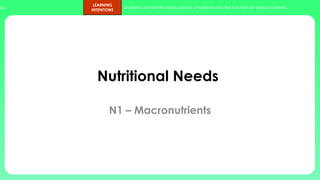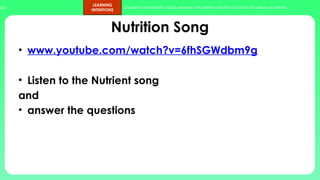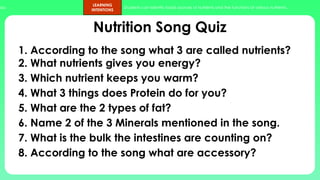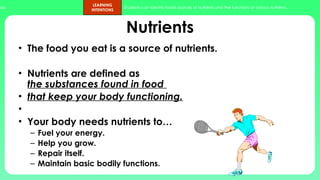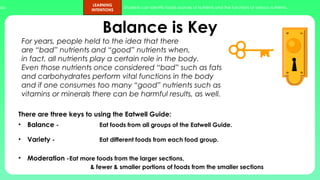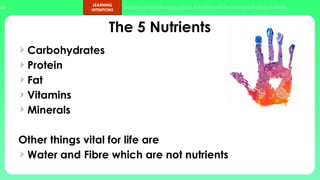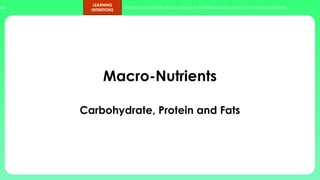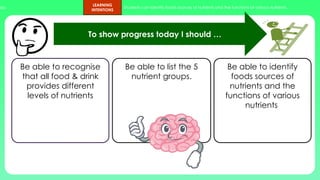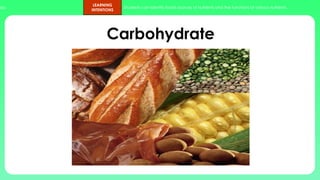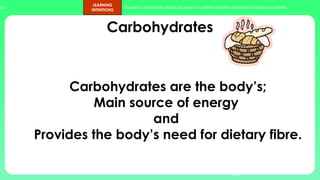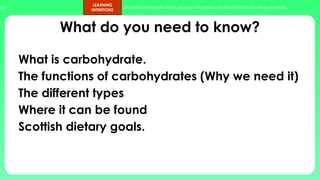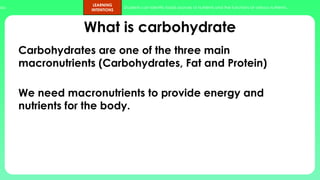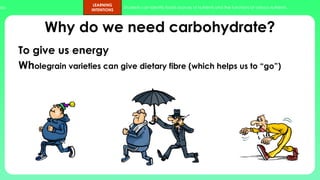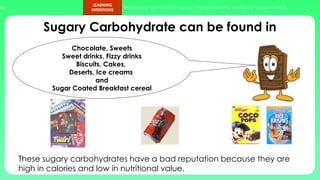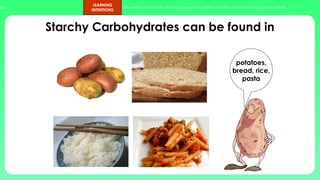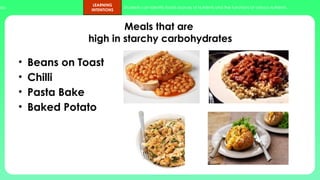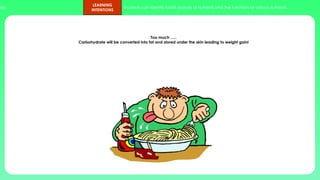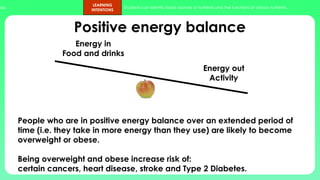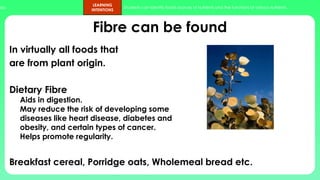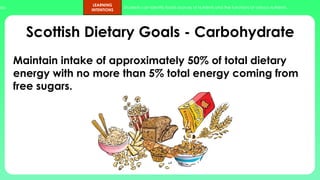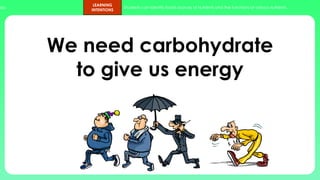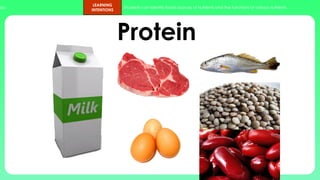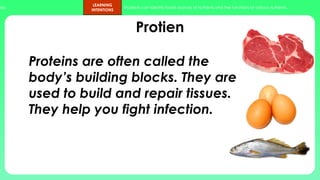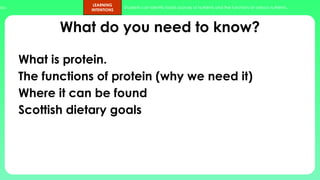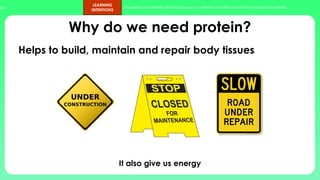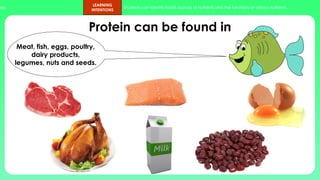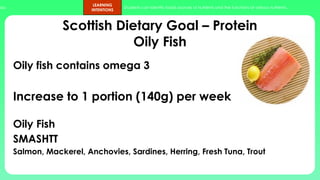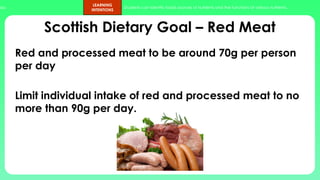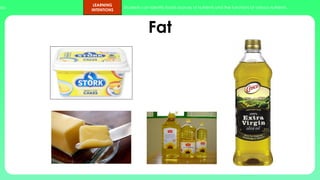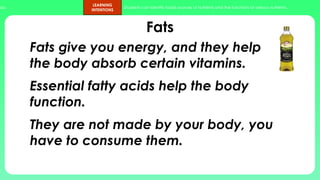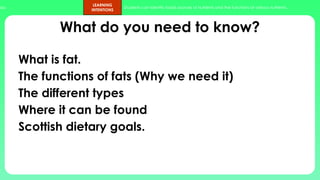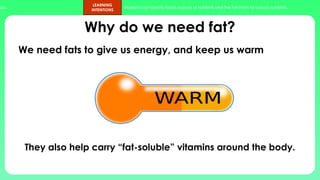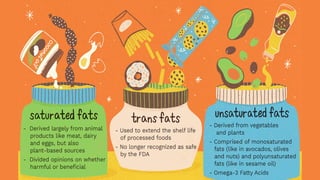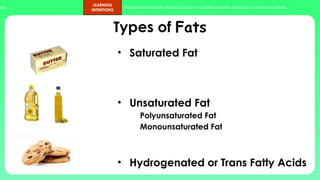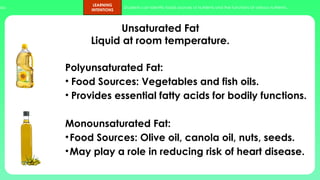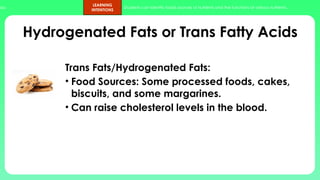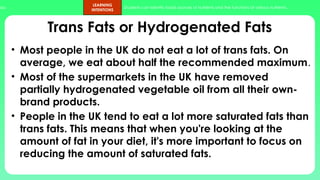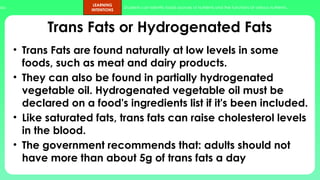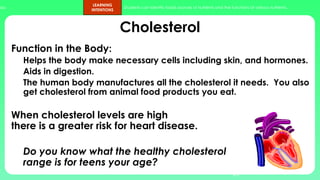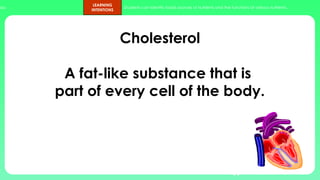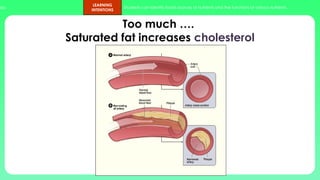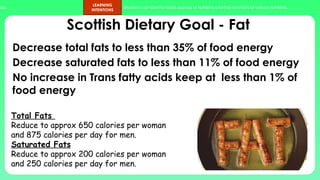NN - Macro-Nutrients - Nutritional Needs of Others
- 1. ups. LEARNING INTENTIONS Students can identify foods sources of nutrients and the functions of various nutrients. Nutritional Needs N1 â Macronutrients
- 2. ups. LEARNING INTENTIONS Students can identify foods sources of nutrients and the functions of various nutrients. Nutrition Song âĒ www.youtube.com/watch?v=6fhSGWdbm9g âĒ Listen to the Nutrient song and âĒ answer the questions
- 3. ups. LEARNING INTENTIONS Students can identify foods sources of nutrients and the functions of various nutrients. Nutrition Song Quiz 1. According to the song what 3 are called nutrients? 2. What nutrients gives you energy? 3. Which nutrient keeps you warm? 4. What 3 things does Protein do for you? 5. What are the 2 types of fat? 6. Name 2 of the 3 Minerals mentioned in the song. 7. What is the bulk the intestines are counting on? 8. According to the song what are accessory?
- 4. ups. LEARNING INTENTIONS Students can identify foods sources of nutrients and the functions of various nutrients. 4 Nutrients âĒ The food you eat is a source of nutrients. âĒ Nutrients are defined as the substances found in food âĒ that keep your body functioning. âĒ âĒ Your body needs nutrients toâĶ â Fuel your energy. â Help you grow. â Repair itself. â Maintain basic bodily functions.
- 5. ups. LEARNING INTENTIONS Students can identify foods sources of nutrients and the functions of various nutrients. Balance is Key There are three keys to using the Eatwell Guide: âĒ Balance - Eat foods from all groups of the Eatwell Guide. âĒ Variety - Eat different foods from each food group. âĒ Moderation -Eat more foods from the larger sections, & fewer & smaller portions of foods from the smaller sections For years, people held to the idea that there are âbadâ nutrients and âgoodâ nutrients when, in fact, all nutrients play a certain role in the body. Even those nutrients once considered âbadâ such as fats and carbohydrates perform vital functions in the body and if one consumes too many âgoodâ nutrients such as vitamins or minerals there can be harmful results, as well.
- 6. ups. LEARNING INTENTIONS Students can identify foods sources of nutrients and the functions of various nutrients. The 5 Nutrients Carbohydrates Protein Fat Vitamins Minerals Other things vital for life are Water and Fibre which are not nutrients
- 7. ups. LEARNING INTENTIONS Students can identify foods sources of nutrients and the functions of various nutrients. Macro-Nutrients Carbohydrate, Protein and Fats
- 8. ups. LEARNING INTENTIONS Students can identify foods sources of nutrients and the functions of various nutrients. Be able to recognise that all food & drink provides different levels of nutrients Be able to list the 5 nutrient groups. Be able to identify foods sources of nutrients and the functions of various nutrients To show progress today I should âĶ
- 9. ups. LEARNING INTENTIONS Students can identify foods sources of nutrients and the functions of various nutrients. Carbohydrate
- 10. ups. LEARNING INTENTIONS Students can identify foods sources of nutrients and the functions of various nutrients. Carbohydrates 10 Carbohydrates are the bodyâs; Main source of energy and Provides the bodyâs need for dietary fibre.
- 11. ups. LEARNING INTENTIONS Students can identify foods sources of nutrients and the functions of various nutrients. What do you need to know? What is carbohydrate. The functions of carbohydrates (Why we need it) The different types Where it can be found Scottish dietary goals.
- 12. ups. LEARNING INTENTIONS Students can identify foods sources of nutrients and the functions of various nutrients. What is carbohydrate Carbohydrates are one of the three main macronutrients (Carbohydrates, Fat and Protein) We need macronutrients to provide energy and nutrients for the body.
- 13. ups. LEARNING INTENTIONS Students can identify foods sources of nutrients and the functions of various nutrients. Why do we need carbohydrate? To give us energy Wholegrain varieties can give dietary fibre (which helps us to âgoâ)
- 14. ups. LEARNING INTENTIONS Students can identify foods sources of nutrients and the functions of various nutrients. 2 types of Carbohydrates Starchy Carbohydrate Also known as or Complex Carbohydrates Sugary Carbohydrate Also known as Simple Carbohydrates
- 15. ups. LEARNING INTENTIONS Students can identify foods sources of nutrients and the functions of various nutrients. Sugary Carbohydrate can be found in These sugary carbohydrates have a bad reputation because they are high in calories and low in nutritional value. Chocolate, Sweets Sweet drinks, Fizzy drinks Biscuits, Cakes, Deserts, Ice creams and Sugar Coated Breakfast cereal
- 16. ups. LEARNING INTENTIONS Students can identify foods sources of nutrients and the functions of various nutrients. Starchy Carbohydrates can be found in potatoes, bread, rice, pasta
- 17. ups. LEARNING INTENTIONS Students can identify foods sources of nutrients and the functions of various nutrients. Meals that are high in starchy carbohydrates âĒ Beans on Toast âĒ Chilli âĒ Pasta Bake âĒ Baked Potato
- 18. ups. LEARNING INTENTIONS Students can identify foods sources of nutrients and the functions of various nutrients. Too much âĶ.. Carbohydrate will be converted into fat and stored under the skin leading to weight gain!
- 19. ups. LEARNING INTENTIONS Students can identify foods sources of nutrients and the functions of various nutrients. Positive energy balance People who are in positive energy balance over an extended period of time (i.e. they take in more energy than they use) are likely to become overweight or obese. Being overweight and obese increase risk of: certain cancers, heart disease, stroke and Type 2 Diabetes. Energy in Food and drinks Energy out Activity
- 20. ups. LEARNING INTENTIONS Students can identify foods sources of nutrients and the functions of various nutrients. Negative energy balance A person is said to be in negative energy balance when there is insufficient energy from the diet to meet energy demands of the body. Energy is derived from energy stores and the person loses weight. People who achieve a negative energy balance over an extended period of time, are likely to become underweight. Underweight can lead to: hair loss, dry, patchy skin, weakened immune system, osteoporosis, infertility and heart failure Energy in Food and drinks Energy out Activity
- 21. ups. LEARNING INTENTIONS Students can identify foods sources of nutrients and the functions of various nutrients. Fibre can be found In virtually all foods that are from plant origin. Dietary Fibre Aids in digestion. May reduce the risk of developing some diseases like heart disease, diabetes and obesity, and certain types of cancer. Helps promote regularity. Breakfast cereal, Porridge oats, Wholemeal bread etc.
- 22. ups. LEARNING INTENTIONS Students can identify foods sources of nutrients and the functions of various nutrients. Scottish Dietary Goals - Carbohydrate Maintain intake of approximately 50% of total dietary energy with no more than 5% total energy coming from free sugars.
- 23. ups. LEARNING INTENTIONS Students can identify foods sources of nutrients and the functions of various nutrients. We need carbohydrate to give us energy
- 24. ups. LEARNING INTENTIONS Students can identify foods sources of nutrients and the functions of various nutrients. Protein
- 25. ups. LEARNING INTENTIONS Students can identify foods sources of nutrients and the functions of various nutrients. Protien Proteins are often called the bodyâs building blocks. They are used to build and repair tissues. They help you fight infection.
- 26. ups. LEARNING INTENTIONS Students can identify foods sources of nutrients and the functions of various nutrients. What do you need to know? What is protein. The functions of protein (why we need it) Where it can be found Scottish dietary goals
- 27. ups. LEARNING INTENTIONS Students can identify foods sources of nutrients and the functions of various nutrients. Why do we need protein? Helps to build, maintain and repair body tissues It also give us energy
- 28. ups. LEARNING INTENTIONS Students can identify foods sources of nutrients and the functions of various nutrients. Protein can be found in Meat, fish, eggs, poultry, dairy products, legumes, nuts and seeds.
- 29. ups. LEARNING INTENTIONS Students can identify foods sources of nutrients and the functions of various nutrients. Scottish Dietary Goal â Protein Oily Fish Oily fish contains omega 3 Increase to 1 portion (140g) per week Oily Fish SMASHTT Salmon, Mackerel, Anchovies, Sardines, Herring, Fresh Tuna, Trout
- 30. ups. LEARNING INTENTIONS Students can identify foods sources of nutrients and the functions of various nutrients. Scottish Dietary Goal â Red Meat Red and processed meat to be around 70g per person per day Limit individual intake of red and processed meat to no more than 90g per day.
- 31. ups. LEARNING INTENTIONS Students can identify foods sources of nutrients and the functions of various nutrients. We need protein for growth, maintenance and repair
- 32. ups. LEARNING INTENTIONS Students can identify foods sources of nutrients and the functions of various nutrients. Fat
- 33. ups. LEARNING INTENTIONS Students can identify foods sources of nutrients and the functions of various nutrients. Fats Fats give you energy, and they help the body absorb certain vitamins. Essential fatty acids help the body function. They are not made by your body, you have to consume them.
- 34. ups. LEARNING INTENTIONS Students can identify foods sources of nutrients and the functions of various nutrients. What do you need to know? What is fat. The functions of fats (Why we need it) The different types Where it can be found Scottish dietary goals.
- 35. ups. LEARNING INTENTIONS Students can identify foods sources of nutrients and the functions of various nutrients. Why do we need fat? We need fats to give us energy, and keep us warm They also help carry âfat-solubleâ vitamins around the body.
- 37. ups. LEARNING INTENTIONS Students can identify foods sources of nutrients and the functions of various nutrients. Types of Fats âĒ Saturated Fat âĒ Unsaturated Fat Polyunsaturated Fat Monounsaturated Fat âĒ Hydrogenated or Trans Fatty Acids
- 38. ups. LEARNING INTENTIONS Students can identify foods sources of nutrients and the functions of various nutrients. Saturated Fat Usually solid at room temperature. â Food Sources: Animal foods and tropical oils. â Most strongly linked to high cholesterol & heart disease
- 39. ups. LEARNING INTENTIONS Students can identify foods sources of nutrients and the functions of various nutrients. Unsaturated Fat Liquid at room temperature. Polyunsaturated Fat: âĒ Food Sources: Vegetables and fish oils. âĒ Provides essential fatty acids for bodily functions. Monounsaturated Fat: âĒFood Sources: Olive oil, canola oil, nuts, seeds. âĒMay play a role in reducing risk of heart disease.
- 40. ups. LEARNING INTENTIONS Students can identify foods sources of nutrients and the functions of various nutrients. Hydrogenated Fats or Trans Fatty Acids Trans Fats/Hydrogenated Fats: âĒ Food Sources: Some processed foods, cakes, biscuits, and some margarines. âĒ Can raise cholesterol levels in the blood.
- 41. ups. LEARNING INTENTIONS Students can identify foods sources of nutrients and the functions of various nutrients. Trans Fats or Hydrogenated Fats âĒ Most people in the UK do not eat a lot of trans fats. On average, we eat about half the recommended maximum. âĒ Most of the supermarkets in the UK have removed partially hydrogenated vegetable oil from all their own- brand products. âĒ People in the UK tend to eat a lot more saturated fats than trans fats. This means that when you're looking at the amount of fat in your diet, it's more important to focus on reducing the amount of saturated fats.
- 42. ups. LEARNING INTENTIONS Students can identify foods sources of nutrients and the functions of various nutrients. Trans Fats or Hydrogenated Fats âĒ Trans Fats are found naturally at low levels in some foods, such as meat and dairy products. âĒ They can also be found in partially hydrogenated vegetable oil. Hydrogenated vegetable oil must be declared on a food's ingredients list if it's been included. âĒ Like saturated fats, trans fats can raise cholesterol levels in the blood. âĒ The government recommends that: adults should not have more than about 5g of trans fats a day
- 43. ups. LEARNING INTENTIONS Students can identify foods sources of nutrients and the functions of various nutrients. Cholesterol Function in the Body: Helps the body make necessary cells including skin, and hormones. Aids in digestion. The human body manufactures all the cholesterol it needs. You also get cholesterol from animal food products you eat. When cholesterol levels are high there is a greater risk for heart disease. Do you know what the healthy cholesterol range is for teens your age? 43
- 44. ups. LEARNING INTENTIONS Students can identify foods sources of nutrients and the functions of various nutrients. Cholesterol A fat-like substance that is part of every cell of the body. 44
- 45. ups. LEARNING INTENTIONS Students can identify foods sources of nutrients and the functions of various nutrients. Too much âĶ. Saturated fat increases cholesterol
- 46. ups. LEARNING INTENTIONS Students can identify foods sources of nutrients and the functions of various nutrients. Scottish Dietary Goal - Fat Decrease total fats to less than 35% of food energy Decrease saturated fats to less than 11% of food energy No increase in Trans fatty acids keep at less than 1% of food energy Total Fats Reduce to approx 650 calories per woman and 875 calories per day for men. Saturated Fats Reduce to approx 200 calories per woman and 250 calories per day for men.
Editor's Notes
- #19: When the diet provides more energy than is needed, it is stored as fat and the person puts on weight over time. People who are in positive energy balance over an extended period of time (i.e. they take in more energy than they use) are likely to become overweight or obese. Excess energy is stored in adipose tissue and can build up if energy intake continues to be too high, or activity levels remain too low. Being overweight or obese is associated with an increased risk of developing certain cancers, cardiovascular disease and type 2 diabetes. Carrying a large amount of weight/fat around the waist also increases the risk of these health problems.
- #20: On the contrary, a person is said to be in negative energy balance when there is insufficient energy from the diet to meet energy demands of the body. Energy is derived from energy stores and the person loses weight. People who achieve a negative energy balance over an extended period of time, are likely to become underweight.
- #43: A normal LDL level in a teenager should beĖýless than 100 mg/dl, Total Cholesterol - Less than 170mg/dL Non-HDL Less than 120mg/dL LDL Less than 100mg/dL LHDL More than 45mg/dL Total cholesterolĖý- a measure of the total amount of cholesterol in your blood. It includes both low-density lipoprotein (LDL) cholesterol and high-density lipoprotein (HDL) cholesterol. LDL (bad) cholesterolĖý- the main source of cholesterol buildup and blockage in the arteries HDL (good) cholesterolĖý- HDL helps remove cholesterol from your arteries Non-HDLĖý- this number is your total cholesterol minus your HDL. Your non-HDL includes LDL and other types of cholesterol such as VLDL (very-low-density lipoprotein). TriglyceridesĖý- another form of fat in your blood that can raise your risk for heart disease
- #44: A normal LDL level in a teenager should beĖýless than 100 mg/dl, Total Cholesterol - Less than 170mg/dL Non-HDL Less than 120mg/dL LDL Less than 100mg/dL LHDL More than 45mg/dL Total cholesterolĖý- a measure of the total amount of cholesterol in your blood. It includes both low-density lipoprotein (LDL) cholesterol and high-density lipoprotein (HDL) cholesterol. LDL (bad) cholesterolĖý- the main source of cholesterol buildup and blockage in the arteries HDL (good) cholesterolĖý- HDL helps remove cholesterol from your arteries Non-HDLĖý- this number is your total cholesterol minus your HDL. Your non-HDL includes LDL and other types of cholesterol such as VLDL (very-low-density lipoprotein). TriglyceridesĖý- another form of fat in your blood that can raise your risk for heart disease

